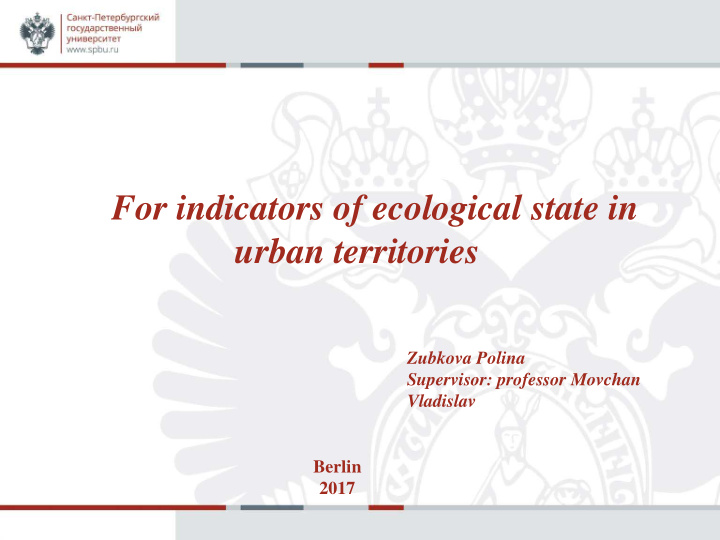



For indicators of ecological state in urban territories Zubkova Polina Supervisor: professor Movchan Vladislav Berlin 2017
Public health is formed by: 1) natural conditions; 2) social and economic factors; 3) technological factors . Factors influencing health (World Health Organization for Russia, 1994) 1. People's way of life - 50-55% 2. State of the environment - 20-25% 3. Genetic factors - 15-20% 4. Medical care - 10-15% 2
Kolpinsky district Petrodvortsovy district Fig. 1. Administrative-territorial division of St. Petersburg, 2016. 3
Kolpinsky district Area: 105,8 km 2 Population: 186 973 17 Plants (15%) 1 Park (3%) 4
Petrodvortsovy district Area : 109 км 2 Population: 135 565 9 parks (30%) фото 5
The main aims are: • to study the health of children as members of risk groups in these areas, • to find out how chemical pollution effects on elemental composition of children’s bioassays (hair). Methods: • statistical (the study of children’s morbidity according to statistical reports), • atomic emission and atomic absorption methods (analysis of children’s bioassays). 6
4 3,69 3,59 3,5 3,15 3,05 3 2,5 2 1,67 1,4 1,5 1,03 1 0,5 0,5 0,5 0,5 0,2 0,1 0,1 0,2 0 HI С NS HI respiratory HI mortality HI blood HI HI growth HI Total system cardiovascular system Center Suburb Fig. 2 Assessment of non-carcinogenic risk in St. Petersburg, 2013 7
Table 1 The structure of the incidence in 2014 of the children’s population of the Kolpinsky and Petrodvortsovy districts Petrodvortsovy district Kolpinsky district Nosological group, diseases of: Number of Specific Number of Specific cases per 1000 weight,% cases per 1000 weight,% Respiratory system 1443,4 70,1 1392,8 64,2 108,4 5,3 145,1 6,7 Digestive system Nervous system 70,7 3,4 164,5 7,6 113,1 5,5 127,7 5,9 Skin and subcutaneous tissue Genitourinary system 44,7 2,2 63,4 2,9 Musculoskeletal system 97,9 4,8 81,4 3,8 43,1 2,1 32 1,5 Endocrine system, metabolic disorders Blood and blood-forming organs 10,8 0,5 13,5 0,6 Neoplasms 10,8 0,5 18,3 0,8 Circulatory system 5,4 0,3 8 0,4 109,9 5,3 121,3 5,6 Infectious and parasitic Total 2058,1 100 2168 100 8
Table 2 The structure of the main nosological groups of the children's population (0-14 years) of Kolpinsky and Petrodvortsovy districts of St. Petersburg in 2014 Nosological group, diseases of: Petrodvortsovy district Kolpinsky district Number of cases per Number of cases per 1000 1000 1443 1393 Respiratory system: Acute respiratory infections of the upper 1348 1290 respiratory tract 33,9 39,1 Acute respiratory infections of the lower respiratory tract 17,7 17,3 Asthma, asthmatic status Nervous system: 70,7 164,5 Disorders of the autonomic nervous system 15,6 25,3 108,4 145,1 Digestive system: Gastritis and duodenitis 16,7 26,7 7,4 Hernia 36,5 22,2 10 Diseases of the gallbladder, biliary tract 9
Detection and correction of disorders of the mineral metabolism of the human body (registered by the Federal Service for Supervision in Health and Social Development, No. FS-2007/128). 10
Table 3 Elemental composition of children's bioassays in Metallostroy and Lomonosov, mg / kg. (The research was carried out using the Resource Center of the Research Park of St. Petersburg State University «С hemistry educational center»). Element Metallostroy (n=74) Lomonosov (n=59) min max Average min max Average «-» Calcium 3345 1031 364 6795 1981 «-» «-» «-» «-» Cadmium 8,7 1,6 «-» Cobalt 0,1 5,4 1,7 8,4 0,8 «-» «-» «-» «-» «-» Chromium 0,24 Copper 2,6 665 174 3,8 117,3 14,4 «-» Iron 77,5 445 180 4397 139 «-» Potassium 19,5 1480 120 952 98 Magnesium 123 715 290 49,7 774,7 229 «-» «-» Manganese 26,8 2,8 10,8 1,6 «-» Sodium 117 520 239 665 90,8 «-» «-» Nickel 4,45 0,3 106 7,8 «-» «-» Lead 19,9 0,6 6,8 1,2 Zinc 63,8 3000 388 21,9 1144 116,3 11
Table 4. Results of analyzes of drinking water samples in Kolpino and Petrodvortsovy districts, 2015. Metallostroy Lomonosov Water Unit quality limits 6,1 7,33 6-9 pH pH Chlorides 1,39 4,84 350 mg/l Sodium 3,25 5,66 200 -«- 0,4 3,9 - -«- Potassium Ammonium 2,39 0,46 2 -«- 0,36 8,4 45 -«- Nitrates Total hardness 1,75 4 7 mole/l eq. мг/л Calcium 5 55,11 400 18 15,2 50 -«- Magnesium Hydrocarbonates 61 244 - -«- - 19 500 -«- Sulphates Iron 0,002142 - 0,3 -«- - Lead 0,003486 0,03 -«- - 0,0002926 1 -«- Copper - Manganese 0,002128 0,05 -«- - 0,0001148 0,1 -«- Cobalt 12
Conclusion: 1. The relationship between the health of children and the state of the environment is revealed. The level of children's health is lower in the Kolpinsky District. 2. The differences in the chemical composition of children’s hair samples from Kolpinsky and Petrodvortsovy Districts is shown. 3. The calcium content in the hair is related to its content in drinking water. 4. To determine the causes of the identified features we plan the assessment of content of the chemical elements in the others fields (soils). 13
Thank you for attention! 14
Recommend
More recommend